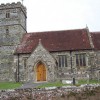Even for a county teeming with many natural and historical wonders, Chesil Beach is in a class of its own and something of an enigma. All hypothesising about its origin has been unable to explain why similar offshore spits have not been deposited elsewhere, though tradition has it that the Chesil was laid down in toto during a very severe storm one night. But why should the sea only deposit its pebbles here? Though it is unlikely the legend could be true, the sea became impounded behind the shingle bar, forming the unique ribbon-like lagoon known as The Fleet.
It was the Saxons who gave us the word ‘Chesil’ meaning shingle. At Portland the end of the beach is well defined, but exactly where the western end should be placed has been a matter of dispute. Some authorities maintain that it ends as far westwards as West Bay (to include Burton Beach and Burton Bradstock); while others hold that it ends at Cogden Beach between Burton Bradstock and West Bexington. There is however, agreement that part of the beach is east of West Bexington, and that there the Fleet is at its most spectacular.
Certainly amazing, though less controversial, are the fascinating facts about this freak of nature. The Chesil is 18 miles long between West Bay and Portland, while from West Bexington to Portland it is 13 miles long. In reality the beach is not built up in one terrace but two, against which the waves break upon the lower and discharge their spray over the upper. At its highest the pebble ridge is 45 feet above mean sea level and 200 yards wide to the Fleet. It has been estimated that the beach contains 50 million tons of pebbles, and that if these were packed into the largest lorries permitted on British roads the convoy would stretch from Dorchester to Perth in Australia! Chesil pebbles were collected by the defenders of Maiden Castle, to use as sling-stones against the Roman army when it attacked that hill fort in 43 CE.
The shingle has a distinct gradation along the beach’s length from west to east, with fine creamy-white oolitic limestone pebbles at the west end, known as pea gravel, to large grey cobbles of Portland limestone at the east end. This indicates that the Chesil originated as an east-to-west deposition of long shore drift and could not therefore have been created as a spontaneous storm deposit as folklore implies. It is this gradation of size and texture that gives the shingle bar such a distinctive sound and feel to the soles of the feet. Many have been proud to be able to complete the end-to-end energy-sapping slog that deadens rhythm and makes ankle injury an ever-present risk.
Fishermen and smugglers have long been able to tell upon which part of the beach they landed after nightfall by the size and feel of the pebbles in their hands. From early times Abbotsbury fishermen have trawled for mackerel off the beach, catching them in seine nets. Daniel Defore writes of these mackerel catches as being so abundant in his day that the fish could be sold onshore at one hundred for just a penny.
No less awesome than the Chesil’s curious facts is its history of notorious savagery towards ships and seamen. Immediately offshore for example, there exists an immensely powerful undertow that can drown even a strong swimmer in only three feet of water five feet from the waterline, and rough seas can throw up fresh shingle banks that can persist for years. During storms the undertow can generate a sucking noise that, it has been said, can be heard in Dorchester. Author Meade Falkner in Moonfleet described how this current caused two fictitious smugglers to fight for their lives in water only three feet deep.
During the age of sail the beach was especially feared. Eastbound ships were in serious difficulties if a storm blew them north-eastwards towards Portland, and there is a sharp shallow water reef that can rip the keels off deep-draughted ships. The combination of the beach’s steep seaward gradient and the underwater current often resulted in shipwrecked passengers and crew being drowned almost in reach of rescuers.
But in 1752 it was said that all of Abbotsbury – including the vicar – were ‘thieves, smugglers and plunderers of wrecks’. In 1822 a Swyre man, Richard Bishop, was jailed for “unlawfully making a light on the sea coast” suggesting that he was signalling to smugglers.
In 1795 seven ships of Admiral Christian’s fleet were lost with two hundred crewmen dead. Then in 1824, during a great storm known locally thereafter as “The Outrage” four ships were lost with all hands (but amazingly the sloop Ebenezer was thrown bodily onto the ridge by a wave, from where it could be re-floated on the Fleet and towed to Portland for a refit). This same gale blew the sea half a mile inland, destroying Fleet village and church before leaving in its wake a hundred bloated corpses on the Chesil shingle. Another storm in 1838 cast five ships onto the shingle bank where they were dashed to pieces, their crews drowned to the last man. A French trawler was wrecked on the shingle bar in 1963.
But the beach has also been the setting for two other non-tragic curiosities. There is a story that in 1757 a mermaid was washed ashore. It is recorded that many people saw her remains, but they generated little excitement as she was supposed to have been no beauty. Then on May 21st, 1802 the crew of the trawler Greyhound landed a huge fish over 26 feet long, 15 feet in girth and weighing 15 tons; it required fourteen horses to drag it ashore. As this monster was positively not a basking shark, it was more likely a whale shark – as this is the largest fish in the sea – while the “mermaid” may have been a manatee or “sea cow” an animal which certainly could be mistaken for an ‘ugly mermaid’ by people who had never before seen one.
The Fleet is eight miles long, though only seven-and-a-half to fifteen feet deep. At its widest it is 900 yards and just 70 yards at its narrowest point and connected to the sea by a channel less that a hundred yards long known as Small Mouth. The lagoon can be walked beside on the seaward side by the fit and dedicated who can then return along the north side on the Dorset Coast Path. Plants typical of shingle beds grow along the margins such as sea holly, sea campion, yellow horned poppy and sea kale, together with beds of reeds and eelgrass. The Small Mouth has the effect of restricting the flow of seawater, making the Fleet brackish, though towards Abbotsbury the salinity is reduced still further by the input of fresh water from streams draining into the lagoon.
Ecologically the result has been the creation of a richly diverse habitat, making the lagoon a premier nature reserve and SSSI encompassed within the World Heritage Jurassic Coast. A hundred species of plants have so far been identified, and many of these, particularly the eelgrass, provide food for a hundred and fifty species of birds, particularly wildfowl, waders, ducks and geese. The water supports a population of twenty species of fish.
All in all it is not just the shingle that can impress the visitor to Chesil Beach, but the bombardment of the senses from stimuli ranging from the smell of seaweed to the cry of gulls. And there is also that stark contrast between each side of the walker’s field of perception: to one side the open sea; to the other a marshland thicket. Truly, this must make Chesil Beach a very peculiar and special place.



